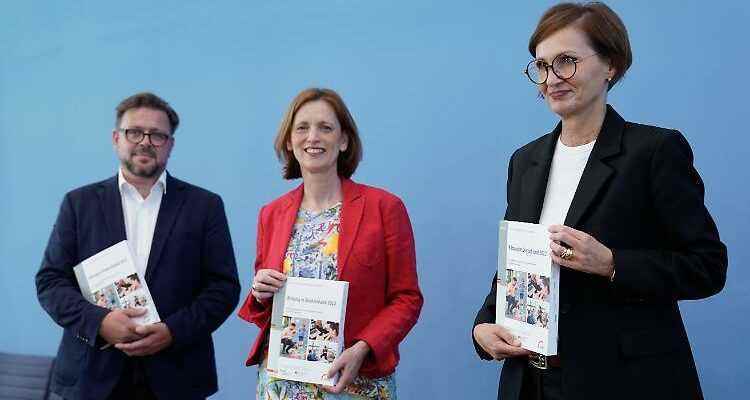“There is a threat of a staff collapse”
Education report reveals significant gaps
06/23/2022, 10:38 p.m
The shortage of skilled workers does not stop at the German education system. The approximately 400-page education report outlines the situation in schools, day-care centers and universities. It is true that more staff could be recruited there recently. But the same cannot be said of the increasing number of children.
Despite the sometimes sharp increase in staff in daycare centers, schools and universities in the past ten years, experts believe that the German education system is facing difficult times due to a shortage of skilled workers. “The issue of personnel requirements is one of the most urgent,” said the managing director of the Leibniz Institute for Research and Information in Education (DIPF), Kai Maaz, in Berlin on the occasion of the presentation of the National Education Report. The Education and Science Union (GEW) warned of a “staff collapse”.
Kai Maaz, Karin Prien and Bettina Stark-Watzinger presented the education report.
(Photo: IMAGO/Political Moments)
The extensive report is created every two years under the leadership of the DIPF. The educational researcher Maaz introduced him in the presence of the Federal Education Minister Bettina Stark-Watzinger and the President of the Conference of Ministers of Education (KMK), Karin Prien. According to the report, personnel recruitment and personnel qualification will remain a priority in the coming years for continued high-quality educational offers. “The question isn’t just how do we get additional staff? It’s also unclear where it’s going to come from. We may see struggles over distribution in the training and job market,” said Maaz. In many areas of the economy or in the health and care sector, skilled workers are desperately needed.
The education report describes developments, trends and problems in the entire education system on around 400 pages – from day-care centers to schools, vocational schools and universities to further education. The scientists evaluated data from statistics and studies and this time chose “educational staff” as the main topic, which should clarify the urgency. The report does say that in daycare centers, schools and universities, for example, the number of staff has increased “sometimes noticeably” since 2010. “Day-care centers alone recorded a 75 percent increase in staff,” it says. However, since the number of children in the day-care centers has also increased, there are still only slight improvements in the ratio of children per kindergarten teacher.
“Altered reproductive behavior”
And according to the authors, the need for staff will continue to rise, especially in early education. Up to 72,500 skilled workers could be missing here by 2025. In addition, there is the agreed entitlement to all-day care, which will be gradually introduced nationwide from the 2026/2027 school year. As a result, a large additional requirement of up to 65,600 skilled workers is also expected in the primary school sector by 2030.
GEW boss Maike Finnern said the system is caught in a vicious circle of overloading due to a shortage of skilled workers and lack of skilled workers due to overloading. “There is a threat of a staff collapse.” Prien said that the shortage of skilled workers affects all areas of life and industries, including education. She also referred to unforeseeable developments. So far, around 140,000 students from the Ukraine have been integrated into the school system “relatively quietly”. A “changed reproductive behavior” is also something that cannot be foreseen, said the Schleswig-Holstein Minister of Education with a view to the increased number of births.
The increasing demands on schools, such as inclusion or language support measures and immigration are also mentioned as further factors for the increasing need for personnel. Other points in the education report:
Educational success depends on origin
The finding is well known and has been confirmed once again: children of parents who earn more and have a high level of education are more successful in school and later on in their education. In the report it sounds like this: “Educational success is directly related to the socio-economic situation of the family”.
Education pays off
“Educational qualifications and skills in school and adulthood are also proving to be profitable in non-monetary terms,” says the report. Translated: Education not only pays off financially, through better jobs. Pupils with better academic performance are also happier with their lives. And adults with higher reading skills rated their life satisfaction higher than those with lower skills.
Fewer early school leavers, but level about the same
The school dropout rate has fallen slightly, but is roughly at the level of the past ten years at around six percent of the population of the same age. In 2020, around 45,000 young people left school without a qualification. It is also said that most of them succeed in catching up on a degree later.
Boom at daycare centers
92 percent of three to six-year-olds are now in day care. Even the very little ones: More than a third of children under the age of three go to daycare or are cared for. The authors see a significant increase here over the past ten years.
“Saturation” when studying
According to the report, almost half of young adults are now studying. According to the report, however, a “saturation level” may have been reached here. “Current forecasts assume that the demand for studies will not increase further in the coming years.”
